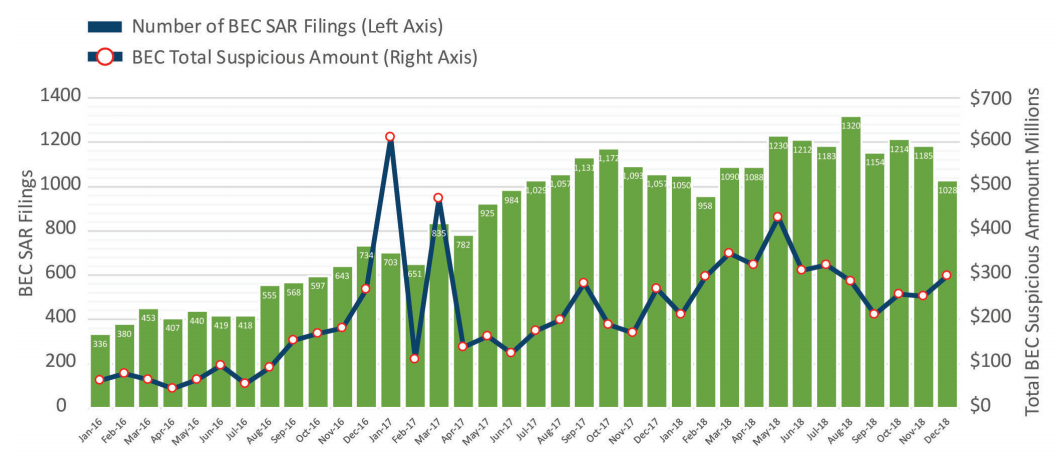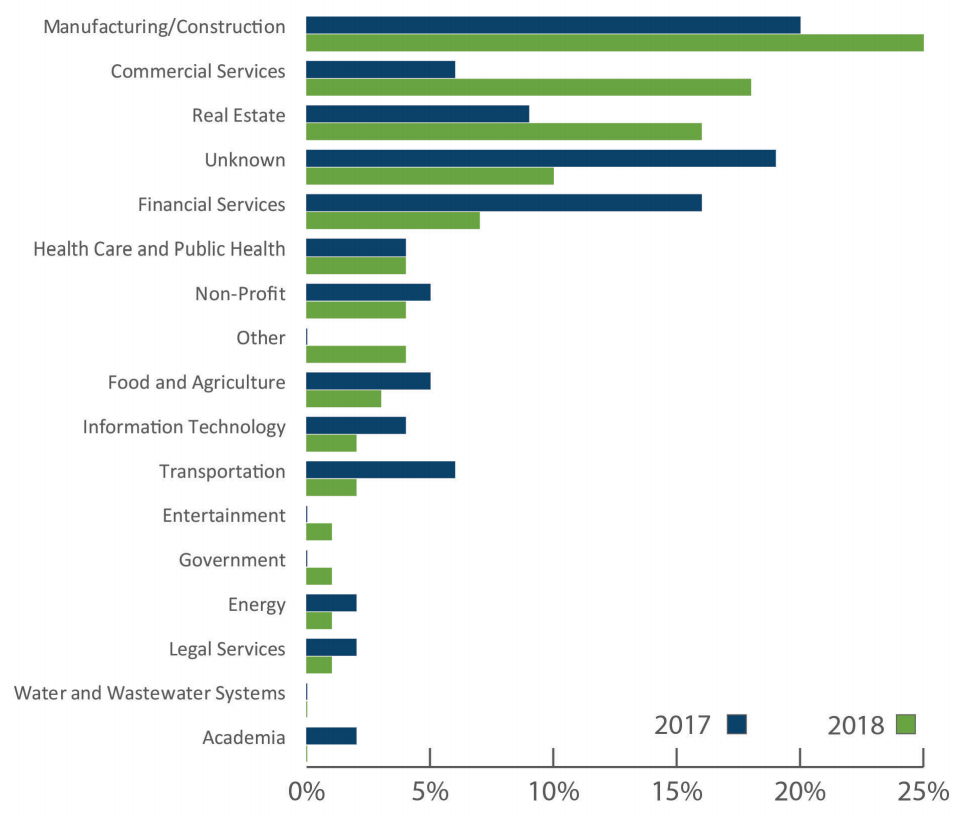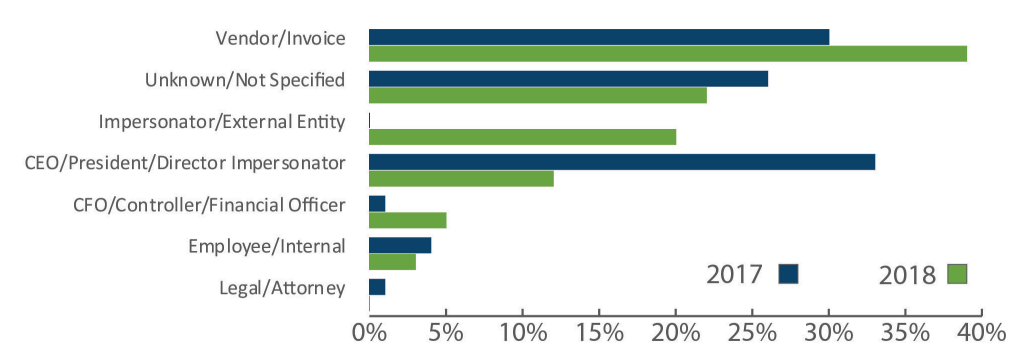
The frequency of business email compromise (BEC) scams has increased year over year and so did the value of attempted thefts, reaching a monthly average of more than $300 million.
The number is drawn from the suspicious activity reports (SARs) received every month since 2016, which increased from 500 to more than 1,100 in 2018.
The Financial Crimes Enforcement Network (FinCEN) compiled statistics about BEC incidents occurring over the past two years and identified the most common types of targets along with the destination intended for the stolen funds and the techniques used by the scammers.
The latest report from Internet Crime Report from FBI’s Internet Crime Complaint Center (IC3) informs BEC scams were responsible for most of the losses generated by cybercrime.
Companies lost $1.2 billion to this sort of cybercriminal activity that aims to obtain funds by posing as a customer or upper management personnel in a company in order to trick key individuals in the organization into wiring funds to an attacker-control bank account.
Statistics are dire
FinCEN’s analysis describes the broader picture of BEC scams stating that while scammers tried to steal in 2016 an average of $110 million per month the value in 2018 grew to $301 million.
According to these numbers, last year alone cybercriminals endeavored to rob companies of more than $3.6 billion.

“In 2016, financial institutions filed nearly 6,000 BEC-related SARs with an average transaction total of $110 million per month. In 2017, the number of BEC-related SARs increased to over 11,000 with a monthly average of $241 million. In 2018, the number of BEC-related SARs rose to nearly 14,000 filings, averaging $301 million in suspicious transactions per month” – FinCEN
Most common victims
The organization’s assessment shows that companies in the manufacturing or construction business were the most frequent targets of email account compromise attacks, accounting for 25% of the victims.
Commercial entities offering professional services like landscaping, retail, restaurants, and lodging became more attractive targets, with 18% of the attacks being aimed at them.
Unlike financial organizations, which fell in the rankings from 16% to 9%, real estate firms turned out to be more tempting, representing 16% of the BEC scam victim pie.

Most of the wire transfers from BEC fraud are domestic, FinCEN observed. In 73% of the cases the beneficiary is in the U.S. and only 27% of the transactions have a foreign destination.
This does not mean that the majority of the threat actors are US-based. These figures likely reflect the fact that cybercriminals use money mules to withdraw the money, which is later distributed across the cybercriminal network and typically ends up abroad.
Top BEC methods
Crooks have different tactics to attain their goal. In 2017 they used to impersonate company CEOs, which have sufficient authority to instruct individuals in charge of making payments to wire money to a specific account.
This approach dropped from 33% to 12% in 2018, indicating that fraudsters are adapting and looking for new ways to play their tricks.
Last year they seemed to prefer impersonating customers and vendors, and used fake invoices in an attempt to get paid. They are also adjusting the sums according to the industry sector tackled.
“The average transaction amount for BECs impersonating a vendor or client invoice was $125,439, compared with $50,373 for impersonating a CEO” – FinCEN
One example in the report is of a Lithuanian man who used fake invoices to defraud multinational companies of at least $100 million; the money was wired to overseas accounts he controlled.

Although the instructions for transferring the money are done over email, scammers need to prepare the message so that it does not raise any suspicions.
For this, they rely on various malware designed to steal the necessary info for perpetrating the attack. Spyware is the common threat as it steals the data necessary to break into email accounts.
However, the trend seems to change. Nigerian fraudsters, who are skilled in the scamming business, started to shift to remote access tools that provide a higher set of capabilities.
Related Articles:
Over $800,000 Stolen by Scammers in Atlanta Area City BEC Fraud
Man Gets 51 Months in Prison for $10M BEC Fraud, Romance Scam
Scattered Canary Evolves From One-Man Operation to BEC Giant
Twitter Can be Tricked Into Showing Misleading Embedded Links
Phishing-as-a-Service Fuels Evasion Methods, Email Scam Growth
Bleeping Computer® is a community of individuals of all ages who are here to learn new information, to help each other, and to help their fellow peers. With that in mind, we ask that all members please follow these simple rules in order to create an atmosphere where everyone feels comfortable.
The rules are as follows:
- All information and instructions given within these forums is to be used at your own risk. By following or using any of this information you give up the right to hold BleepingComputer.com liable for any damages.
- All the forums are categorized by topics. Please post your questions or messages in the appropriate forum.
- Answers to many of the questions you may have can be found in the Tutorials Section, Glossary, or from other posts on the message boards. Please use the search functions, at the top right of each page, to find your answers. If you are still having problems, feel free to post your question.
- All help must be provided in the forums or on our Discord Server. We do not allow support to be provided or requested via personal message, email, or remote desktop control programs (Logmein, TeamViewer, etc).
- If a topic is posted in a forum that is not appropriate for the question, the staff has the right to move that topic to another better suited forum.
- The posting of any copyrighted material on our web site is strictly prohibited.
- Posting links in order to generate affiliate commissions is not permitted at BleepingComputer.com. Any posts that are deemed to be posted in order to generate affiliate commissions, regardless of the product being promoted, will be deleted. If a user continues to create affiliate SPAM posts, they will be banned.
- Posting links to non-Bleeping Computer malware removal guides is NOT permitted with the exception of security vendors who sometimes release specialized tools and instructional documentation. This is because it is impractical for BleepingComputer to monitor and review all such guides for accuracy, no matter how accurate those guides may, in fact, be.
- There will be no use of profanity on our message boards. This will not be tolerated and can lead to immediate suspension.
- When posting, please use proper grammar. Refrain from ‘text-message’ style substitutions of words like ‘u’ for ‘you’, and ‘ur’ for ‘your’. This is a multi-national forum, and some of our non-english speaking members must use translation software which is confused by abbreviations. Most of our volunteer members are very busy helping as many people as they can, and a post that is hard to read will often be overlooked.
- There will be no racial, ethnic, gender based insults or any other personal discriminations. This will not be tolerated and can lead to immediate suspension.
- There will be no posts meant to offend or hurt any other member, in a manner which is offensive or inflammatory. This includes flaming or instigating arguments.
- Spamming is not permitted; please keep all your posts as constructive as possible.
- Pornography, warez, or any other illegal transactions may NOT be linked in any shape or form.
- If you have questions regarding homework, we will only help you with general concepts. If you are looking for a complete solution or answer, we will most likely just delete your post.
- No subject matter will be allowed whose purpose is to defeat existing copyright or security measures. If a user persists and/or the activity is obviously illegal the staff reserves the right to remove such content and/or ban the user. This would also mean encouraging the use or continued use of pirated software is not permitted, and subject to the same consequences.
- If you are receiving assistance in the Virus Removal forum, you are not allowed to request assistance for the same computer at another malware removal forum. This is to prevent conflicting advice from causing issues with your computer or making it unbootable.
- This forum has the right to request alteration or deletion of any offensive post. If this is not done in a prompt manner, the Staff will delete the material themselves.
- Posts may be deleted for any reasons the forum administrators deem reasonable.
- Pictures may be posted as long as they are not explicit, offensive, or copyrighted.
- Advertisements, of any sort, are not permitted. This includes member names and links to commercial sites in Signatures, or in posts. You also may not solicit sales for Newegg through the use of promotion or coupon codes. If you would like to advertise on our site, contact us here.
- In order to reduce spam on the site, you will not be able to add a signature to your account until you reach 25 posts. Signatures are limited to 5 lines or 2000 characters; whichever comes first. If your signature is larger than the allotted size given or deemed unacceptable, you will be requested to adjust your signature. Failure to comply will result in the removal of your signature.
- Only one image per signature. Images in signatures must also be no larger than 500 pixels wide X 90 pixels high. If you have more than one image you will be requested to remove one. If this is not done in a timely manner the staff has the right to modify your signature to abide by these rules.
- Any links in signatures or profiles cannot be commercial in nature or they will be removed by BleepingComputer. You may not put links in your signature soliciting donations unless you are in certain member groups. Those member groups that are allowed will be expressly notified. If you have a personal website or off-site help resource, that is more than fine, but you can not sell products or services through your signature. Multiple links to the same site, unless for a very specific reason, are not permitted in a signature and will be removed.
- Avatars must be in good taste. This means no vulgar or violent images, pornography, or profanity. Avatars that are found to be inappropriate will be removed at the discretion of the staff.
- Linking to hate, anti-Semitic, racist, pornography, warez, or other illegal sites is not permitted.
- Links in your signature must be unobtrusive and can not use formatting so that attention is brought to them.
- Member’s display names can not be email addresses. This rule is in place to protect you from spam bots who will pick up your email address and spam you.
- Members may have only one account on this forum. There is no need to have more than one.
- Any impersonation of a user from these forums, in any mode of communication, is strictly prohibited and will result in a banning.
- Linked and locked topics are pruned regularly to reduce page clutter. If you have a question about where your topic went, please PM a Moderator or Administrator before starting a new topic asking where it went, or posting a duplicate of the original topic. We will be happy to provide you with a link to the new location, or a reason why it was locked and/or removed.
Violation of any of these rules can lead to a banning of the user from our Web Site and a deletion of their account. The consequences will be determined by the Staff on a case by case basis.
When posting you agree that the administrators and the moderators of this forum have the right to modify, delete, edit or close any topic, signature, account, or profile data at any time that they see fit. If you have any questions concerning this, please do not start a new thread, but rather private message to an administrator or moderator.